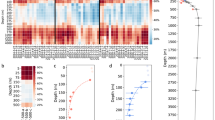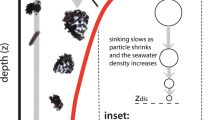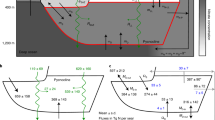Abstract
LARGE, fast-sinking particles are important in the downward transport and redistribution of biogeochemical species in the deep ocean. Using nitrogen isotope ratio, 15N/14N, as an in situ tracer, we investigate the source and transformation of these particles in the North Atlantic ocean. We observe seasonal variations in δ15N associated with seasonal changes in near-surface nitrate concentration and particle flux; the nitrogen isotope variations are consistent with, but much larger than, previously observed variability1,2. Our results show that the signal from these near-surface changes propagates rapidly into the deep ocean, but is modified depending on the phase of the seasonal production cycle. Surprisingly, we find that δ15N values for sinking particles decrease with depth during low-flux periods—behaviour that may occur generally in the open ocean. The sinking particles must therefore be either gaining light nitrogen or losing heavy nitrogen, an effect that we believe requires there to be another source of sinking particles, apart from recent surface production.
This is a preview of subscription content, access via your institution
Access options
Subscribe to this journal
Receive 51 print issues and online access
$199.00 per year
only $3.90 per issue
Buy this article
- Purchase on Springer Link
- Instant access to full article PDF
Prices may be subject to local taxes which are calculated during checkout
Similar content being viewed by others
References
Altabet, M. A. & Deuser, W. G. Nature 315, 218–219 (1985).
Altabet, M. A. & McCarthy, J. J. Deep-Sea Res. 32, 755–772 (1985).
Honjo, S. & Doherty, K. W. Deep-Sea Res. 29, 133–149 (1987).
Deuser, W. G. Deep-Sea Res. 33, 225–246 (1986).
Altabet, M. A. Deep-Sea Res. 35, 535–554 (1988).
Minagawa, M., Winter, D. A. & Kaplan, I. R. Analyt. Chem. 56, 1859–1861 (1985).
Goering, J., Alexander, V. & Haubenstock, N. Estuar. Coast. Shelf Sci. 30, 239–260 (1990).
Wada, E. & Hattori, A. Geomicrobiol. J. 1, 85–101 (1978).
Miyake, Y. & Wada, E. Rec. Oceanogr. Works Japan 9, 37–53 (1967).
Wada, E. & Hattori, A. Geochím. cosmochim. Acta 40, 249–251 (1976).
Eppley, R. W., Renger, E. H. & Betzer, P. R. Deep-Sea Res. 30, 311–323 (1983).
Saino, T. & Hattori, A. Nature 283, 752–754 (1980).
Menzel, D. W. & Ryther, J. H. Deep-Sea Res. 7, 282–288 (1961).
Honjo, S. in Polar Oceanography, Part B: Biology, Chemistry and Geology (ed. Smith, W. O. Jr) 687–739 (Academic, New York, 1990).
Minagawa, M. & Wada, E. Geochim. cosmochim. Acta 48, 1135–1140 (1984).
Wada, E., Terazaki, M., Kabaya, Y. & Nemoto, T. Deep-Sea Res. 34, 829–841 (1987).
Fry, B. Limnol. Oceanogr. 33, 1182–1190 (1988).
Deuser, W. G. et al. Deep-Sea Res. 37, 1331–1343 (1990).
Saino, T. & Hattori, A. Deep-Sea Res. 34, 807–827 (1987).
Gaebler, O. H., Vitti, T. G. & Vukmirovich, R. Can. J. Biochem. 44, 1249–1257 (1966).
Bacon, M. P., Huh, C., Fleer, A. P. & Deuser, W. G. Deep-Sea Res. 32, 273–286 (1985).
Siegel, D. A., Granata, T. C., Michaels, A. F. & Dickey, T. D. J. geophys. Res. 95, 5305–5311 (1990).
Macko, S. A., Fogel, M. L., Hare, P. E. & Hoering, T. C. Chem. Geol. 65, 79–92 (1987).
Lee, C. & Cronin, C. J. mar. Res. 42, 1075–1097 (1984).
Ittekkot, V., Deuser, W. G. & Degens, E. T. Deep-Sea Res. 31, 1057–1069 (1984).
Druffel, E. R. M. & Williams, P. M. Nature 347, 172–174 (1990).
Martin, J. H., Knauer, G. A., Karl, D. M. & Broenkow, W. W. Deep-Sea Res. 34, 267–285 (1987).
Bratbak, G. Appl. envir. Microbiol. 49, 1488–1493 (1985).
Lee, S. & Fuhrman, J. A. Appl. envir. Microbiol. 53, 1298–1303 (1987).
Liu, K.-K. & Kaplan, I. R. Limnol. Oceanogr. 34, 820–830 (1989).
Altabet, M. A. Limnol. Oceanogr. 34, 902–909 (1990).
Author information
Authors and Affiliations
Rights and permissions
About this article
Cite this article
Altabet, M., Deuser, W., Honjo, S. et al. Seasonal and depth-related changes in the source of sinking particles in the North Atlantic. Nature 354, 136–139 (1991). https://doi.org/10.1038/354136a0
Received:
Accepted:
Issue Date:
DOI: https://doi.org/10.1038/354136a0
This article is cited by
-
Nitrogen isotopic fractionation of particulate organic matter production and remineralization in the Prydz Bay and its adjacent areas
Acta Oceanologica Sinica (2020)
-
Sources and transformations of nitrogen in the South China Sea: insights from nitrogen isotopes
Journal of Oceanography (2018)
-
Hidden diversity in two species complexes of munnopsid isopods (Crustacea) at the transition between the northernmost North Atlantic and the Nordic Seas
Marine Biodiversity (2018)
-
Foraging segregation and genetic divergence between geographically proximate colonies of a highly mobile seabird
Oecologia (2012)
-
Isotopic composition of nitrogen in suspended particulate matter of Lake Superior: implications for nutrient cycling and organic matter transformation
Biogeochemistry (2011)
Comments
By submitting a comment you agree to abide by our Terms and Community Guidelines. If you find something abusive or that does not comply with our terms or guidelines please flag it as inappropriate.



